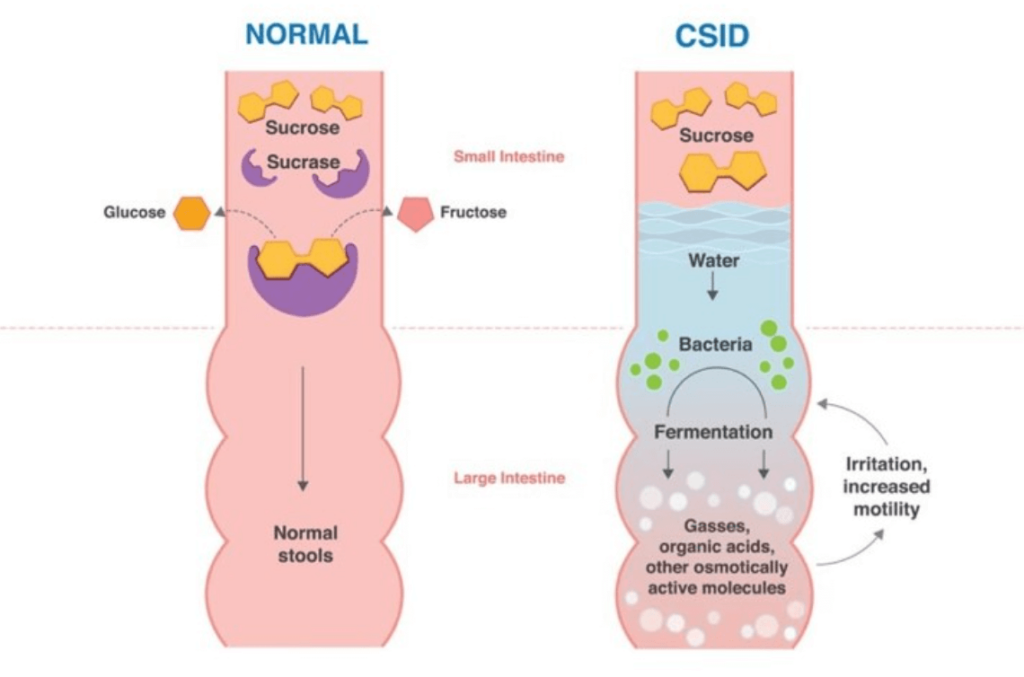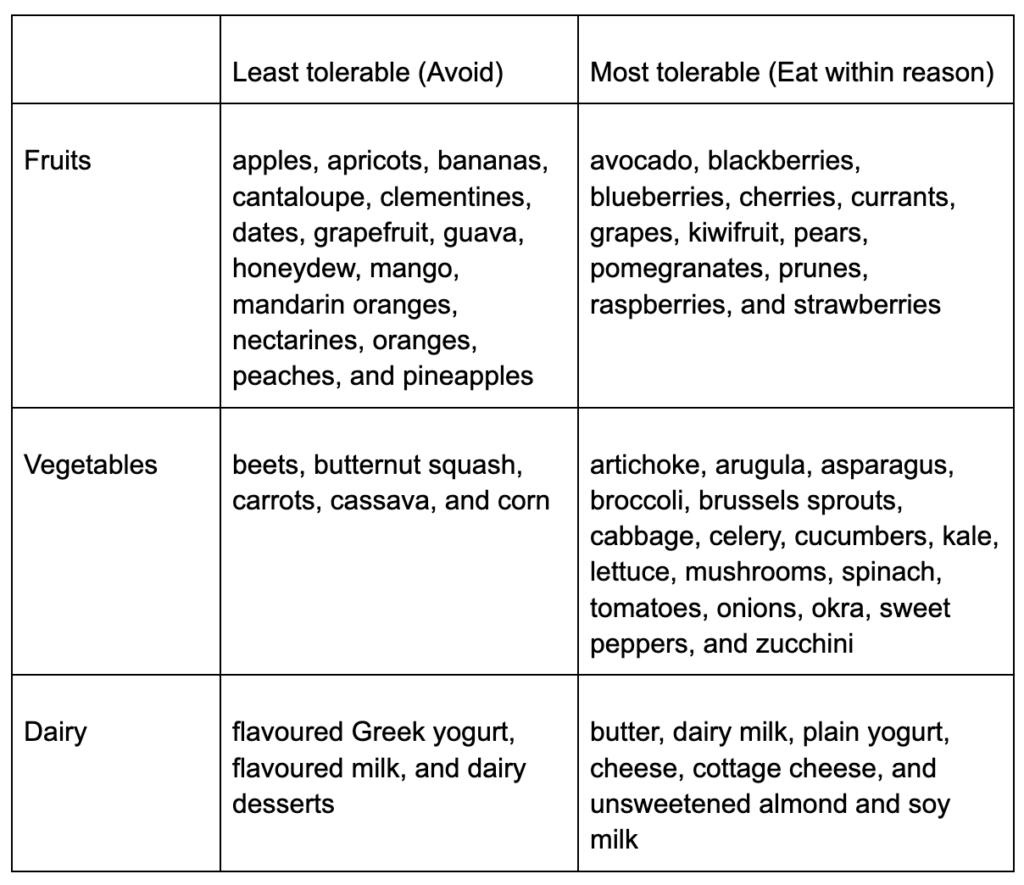Raina was at her friend Sam’s place to work on a school project. Around lunch, Sam’s mom placed a tray of chicken sandwiches in front of them. Raina picked up a sandwich, opened it and ate only the chicken filling. Seeing this, Sam’s mom said, “I am sorry, I wasn’t aware that you were gluten intolerant”. Raina replied, “I am not. I have Congenital Sucrase-Isomaltase Deficiency (CSID), and I can’t digest sugar or carbs”.
It’s safe to assume that it took Raina a better part of an hour to explain to Sam’s mom that she did not make up this condition just so that she could avoid foods that would make her fat. Maybe Sam’s mom needed convincing because she had never heard of CSID, like most people, and as a result, even if someone is experiencing the condition, they may just misdiagnose or pass it off as something like irritable bowel syndrome (IBS).
So what is this condition, and why is it relatively unknown? Here’s breaking it down.

Highlights
- Congenital sucrase-isomaltase deficiency (CSID) is a rare genetic disorder,
- Symptoms can include gastrointestinal (GI) complaints such as chronic, watery, acidic diarrhoea, gas, bloating and abdominal pain,
- Enzyme replacement therapy through Sucraid (sacrosidase) Oral Solution can be effective in controlling the symptoms of CSID.
Understanding CSID
CSID is a rare genetic disorder affecting one in 500 to one in 2,000 people of European descent, and even fewer African Americans are thought to be affected. CSID impairs a person’s ability to digest certain sugars, primarily sucrose and maltose. The condition is also known by other names such as Genetic sucrase-isomaltase deficiency (GSID), Congenital sucrose intolerance, Congenital sucrose-isomaltose malabsorption, and Disaccharide intolerance I, SI deficiency, or sucrase-isomaltase deficiency.
To understand this better, let’s familiarise ourselves with how sugar is broken down in our bodies. During digestion, sucrose breaks down into glucose, and another simple sugar called fructose and maltose breaks down into two glucose molecules. Sucrose is also known as table sugar and is found in fruits. Maltose, the sugar found in grains, is called disaccharides because they are made of two simple sugars.
People suffering from CSID cannot digest the sugars sucrose, maltose, and other compounds made from these sugar molecules (carbohydrates), leading to many chronic gut problems.
Sucrose digestion: normal digestion vs symptoms with CSID

In the above image, during a normal digestion process, dietary sucrose is digested by sucrase into two subunits, glucose and fructose, which are then quickly absorbed into the bloodstream, resulting in normal stools. For someone with CSID, sucrase is absent or dysfunctional and dietary sucrose is not digested into its two subunits (glucose and fructose). Consequently, sucrose is not absorbed by the small intestine and undergoes bacterial fermentation in the large intestine.
The by-products of this fermentation are gases, organic acids, or other osmotically-active molecules, causing postprandial abdominal distention and pain and water retention producing watery acidic diarrhoea. The severity of the symptoms can vary and often depends on the amount of sucrose and starch consumed and the degree of sucrase and/or isomaltase enzyme activity present.
What causes CSID?
Mutations in the SI gene lead to congenital sucrase-isomaltase deficiency. The SI gene gives instructions for creating the enzyme sucrase-isomaltase. This enzyme is found in the small intestine and is in charge of breaking down sucrose and maltose into their simple sugar components, which are then absorbed by the small intestine.
Mutations that cause CSID to change the structure, disrupt the production, or impair sucrase-isomaltase function, which prevents the enzyme from breaking down sucrose and maltose, causing intestinal discomfort. In addition to these genetic discrepancies, issues like dietary health, gut motility, and nutritional interactions and interferences may also exacerbate the severity of the symptoms.
Who can CSID affect?
It’s important to know that this condition is not caused due to any dietary or lifestyle changes; rather, it’s a rare inherited disease. CSID is inherited in an autosomal recessive pattern, which means both copies of the gene in each cell have mutations. The parents of an individual with an autosomal recessive condition each carry one copy of the mutated gene. However, they do not typically show any symptoms of the condition. So, a person suffering from CSID can have parents with a normal digestive system.

What are the symptoms of CSID?
People with CSID can show symptoms ranging from mild to severe gastrointestinal (GI) complaints such as chronic, watery, acidic diarrhoea, gas, bloating, and abdominal pain. Symptoms in children can be more severe when compared to adults because children have shorter gastrointestinal tracts. Symptoms of CSID usually become apparent when a baby is weaned from mother’s milk and introduced to solid foods, namely fruits and grains.
Some of the common symptoms of CSID in small children include:
- Chronic abdominal pain
- Watery diarrhoea
- Failure to thrive (poor physical growth)
- Malnutrition
- Abdominal swelling (distention)
- Gassiness
- Chronic colic
- Irritability
- Excoriated (abrasions and irritations) buttocks
- Vomiting
- Diaper rash
Symptoms in adults are almost the same as those experienced by babies and children. However, since the adult gastrointestinal tract is longer, their symptoms may not be as pronounced or as frequent. CSID is also sometimes diagnosed in older kids and adults; however, the frequency is not yet determined, and this condition often gets confused with IBS (irritable bowel syndrome), celiac disease, gluten intolerance or dyspepsia.
Some of the common symptoms of CSID in adults include:
- Abdominal cramps and bloating
- Abdominal distension and pain
- Excess gas production, flatulence
- Nausea and vomiting
- Dyspepsia (indigestion)
- Chronic diarrhoea and/or loose stools
- Diarrhoea mixed with intermittent constipation, particularly when chronically taking common drugs to stop diarrhoea
- High frequency of bowel movements (BMs)
- Reports of particularly foul BM odour related to poor absorption of carbohydrates
- Weight loss
- Hypoglycemia and headaches
- Upper respiratory tract and viral diseases
- Anxiety and heart palpitations
How to diagnose CSID?
It can be a very difficult and time-consuming effort to get a correct diagnosis for CSID since the symptoms are similar to other health conditions such as IBS, celiac disease, intestinal infections and more. A few tests help diagnose CSID, and your physician may choose one depending on factors like age, the severity of the condition, etc. Following are a couple of tests used by physicians to diagnose CSID.
What kind of tests can diagnose CSID?
Gastrointestinal endoscopy test (GET)
This is one of the most accurate tests to determine CSID. In a gastrointestinal endoscopy test, multiple biopsies (tissue specimens) are taken from the small intestine and sent to the laboratory for specialised analysis of the enzymatic activity of a number of disaccharide enzymes, including sucrase and isomaltase.
The laboratory analysis that determines this enzyme activity is commonly known as a disaccharidase assay via a small bowel biopsy. Post measuring the activity of these intestinal disaccharidases (lactase, sucrase, isomaltase or palatinase, and maltase-glucoamylase), a possible diagnosis of CSID can be arrived at. Since GET is a very invasive method, your physician may suggest the following breath tests.
Breath tests
Sucrose Hydrogen Methane Breath Test: This non-invasive test measures the levels of hydrogen gas in an individual’s breath post sucrose ingestion. This test was created based on the reasoning that bacteria in the large intestine can produce hydrogen gas in the human gut when exposed to undigested food, especially sugars and carbohydrates.
A substantial volume of hydrogen gas is produced when there is an issue with the digestion or absorption of food in the small intestine, allowing more undigested food particles to reach the large intestine. When there is an increase in hydrogen gas in exhaled breaths after ingesting a set amount of sucrose, it can indicate that the small intestinal enzymes are not functioning properly.
13C- Sucrose Breath Test: This simple, non-invasive breath test measures sucrase activity. The test involves using a sucrose solution containing naturally occurring 13C as the test nutrient. Sucrose is broken down by sucrase, which then splits 13C-sucrose into 13C-glucose and 13C-fructose.
These sugars are absorbed through the mucosal cells and will be metabolised in the liver, releasing 13CO2, which is then moved by the blood to the lungs, where it is expelled in the breath. The release of 13CO2 in breath can be compared with the amount of sucrase activity in the small intestine. People suffering from CSID will release lower levels of 13CO2.
Sugar challenge test
The 4-4-4 sugar challenge test is a simple, short test that can be carried out by an individual at home. Dissolve four tablespoons of table sugar into four ounces (approximately 120 ml) of water and drink it on an empty stomach. If the individual showcases symptoms of bloating, gas, and/or diarrhoea during the next four to eight hours, then it can be suggestive of decreased sucrase activity and possible CSID. Please note that even though it’s a simple test that can be done at home without assistance, you need to consult your doctor beforehand.

How to treat CSID?
CSID is a non-curable disease; however, its symptoms can be managed through enzyme replacement therapy and diet modification that cuts out foods containing sucrose (table sugar) or starch sugars.
Enzyme Replacement Therapy
Enzyme replacement therapy through sucraid (sacrosidase) oral solution is a pharmacological alternative to sucrose-free restricted diets. Sucraid was originally approved by the US Food and Drug Administration (FDA) in 1998 for treating CSID and continues to remain the only FDA-approved therapy for the treatment of genetically determined sucrase deficiency, which is part of CSID.
This enzyme replacement therapy is available only by prescription. It has shown to be effective in decreasing the symptoms of CSID and allows for a less restrictive diet. Sucraid is a liquid preparation that is tasteless when mixed with water. The proper dosage to keep in mind is 1 mL or 2 mL (one or two full measuring scoops) with each meal or snack. The proper dose of Sucraid by body weight is:
- For patients weighing up to 33 lb (15 kg): 1 mL (one full measuring scoop)
- For patients weighing more than 33 lb (15 kg): 2 mL (two full measuring scoops)
The appropriate dose of Sucraid needs to be diluted with two to four ounces (60 to 120 mL) of water or milk and should be taken orally with each meal or snack. As heat and acidity can reduce the potency of Sucraid, it is advised not to warm the liquid; use it with hot beverages or mix it with acidic fruit juices like orange juice. Taking roughly half of the dose before a meal and the other half post-consumption is recommended. For Sucraid to be effective, proper dosing should be followed diligently.
CSID Diet: Foods to eat and avoid
To alleviate the symptoms of CSID, one needs to restrict diets that are rich in sucrose and starch. Follow an elimination diet, preferably under the guidance of a registered dietician, to ascertain which foods are fairly tolerable and which foods you need to avoid.
Generally speaking, starchy vegetables like carrots and corn, legumes like chickpeas, soybeans, potatoes and almost all grains, especially wheat and rice, are loaded with sugars and starch and hence need to be avoided when following a CSID diet. One also needs to stay away from processed foods like cakes, ice creams, cookies, beverages like canned fruit juices, cola, sports drinks and condiments like salad dressings and sauces.

A good CSID diet should be rich in clean proteins like eggs, poultry, low starch and low sugar vegetables like mushrooms, spinach, etc. You can also indulge in unsweetened tea and coffee, and if you are of legal drinking age, then you can consume spirits like whisky, vodka, tequila, and rum with sucrose-free mixers, albeit in moderation.
Conclusion
CSID is a rare genetic disorder that prevents your body from completely digesting and absorbing sucrose and starch. It is inherited in an autosomal recessive pattern and is caused by genetic changes in the SI gene. Among infants, symptoms of CSID usually show up when the baby is weaned from the mother’s milk and starts consuming semi-solid and solid foods like mashed fruits, vegetables and cereals. Some adults may show symptoms of CSID at a later stage. These include stomach cramps, bloating, excess gas production, and diarrhoea.
Getting the right treatment for CSID can be time-consuming as its symptoms are often confused with IBS, intestinal infections, parasites, etc. Tests like gastrointestinal endoscopy tests and breath tests can ascertain whether one has CSID. Although not curable, one can alleviate the symptoms of CSID through enzyme replacement therapy through sucraid (sacrosidase) oral solution and follow an elimination diet that restricts foods rich in sugar and starch.
Disclaimer: The contents of this article are for general information and educational purposes only. It neither provides any medical advice nor intends to substitute professional medical opinion on the treatment, diagnosis, prevention or alleviation of any disease, disorder or disability. Always consult with your doctor or qualified healthcare professional about your health condition and/or concerns and before undertaking a new healthcare regimen including making any dietary or lifestyle changes.
Reference
- Congenital Sucrase-Isomaltase Deficiency (CSID)
- CSID Symptoms
- What Are the Symptoms of Congenital Sucrase-Isomaltase Deficiency?
- Treatments for CSID
- CSID Diet: Foods to Avoid, Meal Plan, and More
About the Author
Priti Noronha has worked in the advertising field for over a decade as a copy professional. To attain a healthier lifestyle, she started exploring more about health, nutrition, exercise and lifestyle choices. Now, in her free time she likes to share this wealth of information in a creative and concise way.







